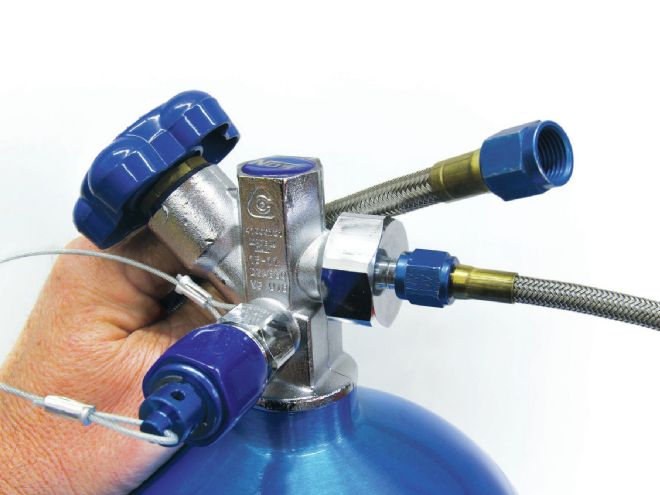
Nitrous is the great equalizer. Used properly, it can transform a mediocre street runner into a giant killer. It's not unusual to see what appears to be a simple 200hp plate to actually be pushing closer to 500 hp. Then there are the fogger systems that can make even more. Induction Solutions (Induction Solutions.com) posted a short video on its home page showing an 18-degree SBC intake manifold “levitating” off the bench with a 600hp shot shooting out of the fogger nozzles. With these big horsepower numbers also comes major tuning responsibility: you'd best have your all ducks beak-to-tail if you're going to play with nitrous. More importantly, the basics of nitrous tuning remain the same for all systems, no matter how much or how little nitrous you push through an engine. Not surprisingly, it's many of these same basics that are often overlooked or ignored in the rush to go fast. If you're lucky, the cost of this ignorance is merely unrealized horsepower. But this same inattention can just as easily escalate into more costly mistakes.
Nitrous is expensive and, like you, we want to get the most horsepower bang for our N2O buck. So went looking for the tricks that the smart nitrous tuners know all too well. It turns out that a properly tuned nitrous system has less to do with magic and more about acknowledging all the little details that make each nitrous pass more consistent. Let's dig into those details and see if there are a few you may have overlooked.
Under Pressure
If there is one overriding factor that affects fast gas tuning, it has to be nitrous pressure. We see it all the time with part-time racers and street runners who want to go fast but may not understand the basics about pressurized gases. We'll start with the nitrous in the bottle. A full bottle at room temperature (72 degrees F) will be at 760 psi, and most of the nitrous oxide will be in a liquid state. Below this pressure, nitrous will begin to phase change from a liquid to a gas, which is less dense. The object is to inject liquid nitrous at the discharge nozzle to maximize the benefit of both the nitrous and its cooling effect. You may be aware that nitrous exits a nozzle (or anywhere there's a leak) at roughly –120 degrees. That's why it so easily burns bare skin when released under pressure. Conversely, if we warm the bottle using hot water or a heat blanket (never, ever an open flame), pressure in the bottle will increase. But the critical pressure/temperature window is rather narrow. If the bottle reaches a temperature in excess of 98 to 100 degrees, the nitrous begins the process of changing back from a liquid into a gas. This means the ideal nitrous pressure is midpoint within this ideal pressure/temperature range—between 84 and 88 degrees, which is equivalent to 900 to 950 psi. This means that on hot days, you will have to cool the bottle with ice or wet towels, while you will have to warm the bottle to maintain this optimal pressure on cool race nights.
According to long-time nitrous tuner Steve Johnson, owner of Induction Solutions, it's better to be a little on the low/cool side of the pressure/temperature curve than on the hot side. It's not uncommon to see nitrous bottles with temperatures barely at 70 degrees (670 psi), which is too low and will deliver less than optimal power. Conversely, jacking nitrous pressure up over 1,050 psi degrades nitrous performance because some of the liquid nitrous will revert back to a gas—not what you want. A fairly common summertime affliction is when bottle pressure spikes because of excess heat. The first indication of this excess pressure will be when the nitrous solenoid won't open when triggered. Steve says that pressure in excess of 1,000 psi is the leading cause of damage to the nitrous solenoid seal, and a leaking nitrous solenoid is the most common cause of nitrous backfires. If you've ever witnessed one of these explosions, we don't need to tell you how badly it mangles the carburetor and sometimes even the intake manifold. There's a good reason companies sell nitrous burst plates to help vent the violence. Don't be the guy who launches a 10-foot flame out of his carburetor.
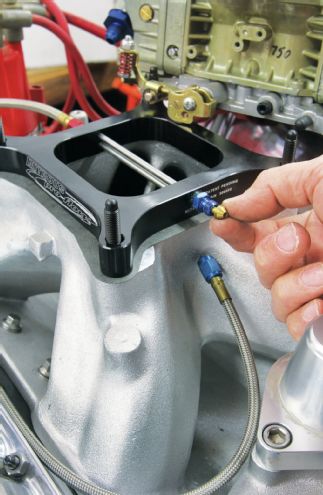
Making more horsepower is as easy as swapping nitrous jets and hitting the button. Tune it right, and there's plenty of power available.
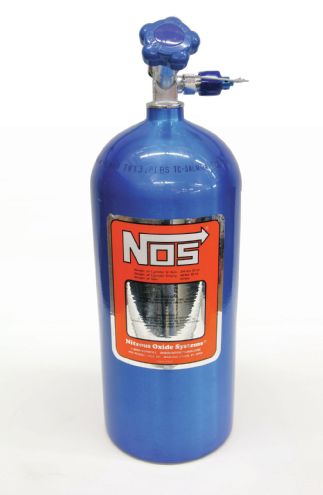
Nitrous bottle weight is a critical variable. A properly filled bottle will retain roughly 50 percent of area for the gas above the same level of liquid nitrous. This “head room” creates less of a pressure drop when the nitrous is used. An overfilled bottle means there's less area above the liquid nitrous. The area above the liquid nitrous on an overfilled bottle increases dramatically, causing a greater than normal pressure drop during the initial use. This NOS bottle lists bottle weight at 14 pounds, 10 ounces; with 10 pounds of nitrous, the bottle should weigh 24 pounds, 10 ounces.
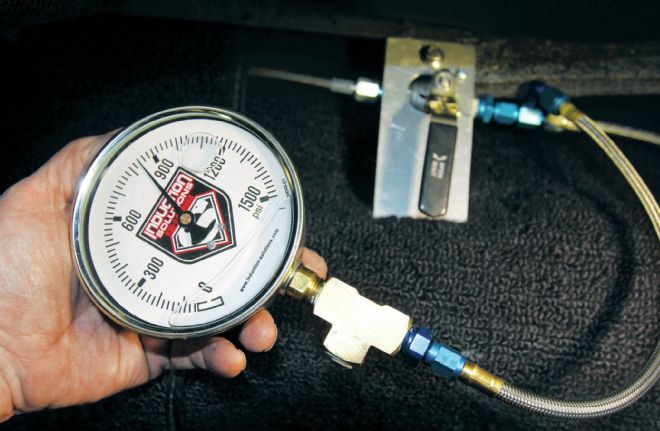
We put an Induction Solutions quarter-turn ball valve and 4-inch, liquid-filled, nitrous-pressure gauge in the cockpit of our Orange Peel Chevelle. This way we can accurately monitor nitrous bottle pressure and increase the nitrous solenoid seal life by isolating bottle pressure from the solenoid until right before use. Steve Johnson says that long-term exposure of the nitrous solenoid seal to bottle pressure will quickly degrade the seal.
Dynamic fuel pressure is the next critical tuning element. A common error nitrous users make is to assume the fuel pump can maintain the same pressure under a 200hp nitrous hit as it does at idle. With a single pump supplying fuel for both the engine and the nitrous system, demand can easily amount to a total fuel delivery load of 500–600 hp worth of fuel, or about 250–300 pounds per hour (lbs/hr). Even at these mild fuel-delivery loads, your existing fuel pump may be taxed beyond its capacity. When this happens, the fuel pressure will drop as power increases, the engine will run lean, and the next thing you realize is you have a dead hole and a burned piston.
The only way to know the capacity of your fuel-delivery system is to test it like it will be used. This is easy if there is a separate nitrous fuel-delivery system with an electric pump. Several companies like ZEX and Induction Solutions offer dynamic pressure testers, but all operate the same way. The test involves disconnecting the output from the fuel regulator, connecting it to a T fitting with an accurate fuel-pressure gauge. The outlet from this T employs an AN fitting holding the fuel-enrichment jet. To test the system, mount the fuel jet and dump the outlet into a fuel jug. Turn on the nitrous fuel pump and measure the fuel pressure. Changing the pressure is as easy as adjusting the regulator to the required fuel pressure (usually 5–6 psi). Once set, the system is ready to rock.
If the nitrous system pulls fuel from the engine's fuel-delivery system, then testing is a bit more complicated because the only accurate test is to simulate both the nitrous and the engine under full-throttle load. The easiest way to do this is to turn off the nitrous bottle, run the engine on the road near the top of Second gear, for example, and engage the nitrous system (which will open both solenoids, but no nitrous will flow because the bottle is off) and watch the fuel-pressure gauge. The engine will run excessively rich for a second or two during this test, and the rpm will probably drop, but the key is to watch the fuel pressure since this will duplicate the amount of fuel used by both the engine and the nitrous system. Then you can adjust the fuel pressure accordingly.
We should also discuss fuel octane with nitrous. Most of the nitrous companies recommend that you increase the fuel's octane rating above 91 to 93 premium octane once the nitrous tune exceeds the 150–200hp level. Adding nitrous at 200-plus-horsepower ratings demands a minimum of mixing 100-octane fuel with your base pump gas. This is an acceptable approach, and octane will increase on a predictable linear basis. For example, 5 gallons of 93-octane pump gas mixed with 5 gallons of 100-octane unleaded race gas will produce a fuel load with an octane rating of 96.5.
Rockett Brand Racing Fuel, VP Racing Fuels, and others offer 100-octane unleaded gasoline that is legal to use on the street and will not affect the use of air/fuel-ratio sensors that can be damaged if used with leaded fuel. When evaluating race fuel, the overall octane number is attained by adding the motor octane number (MON) to the research octane number (RON) and dividing by two. For nitrous use, pay closer attention to the fuel's MON number. Choose a fuel within an overall octane number you need that has the higher MON number. There's much more to this story on fuels when using nitrous, but a safe start is to start tuning with a higher-octane fuel and then tune accordingly.
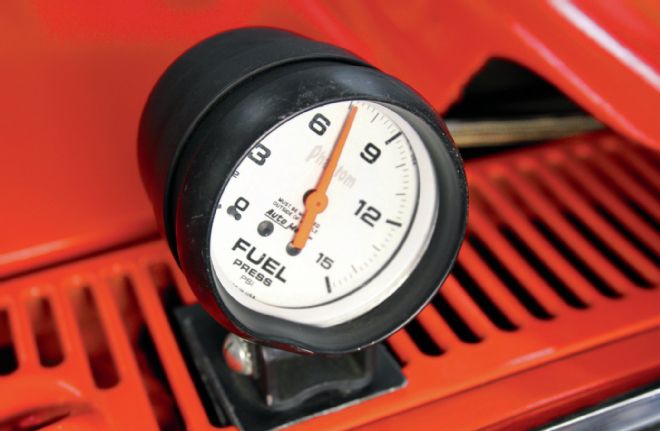
Fuel pressure is an equally important part of the nitrous tune. Most systems are tuned for 5–6 psi of fuel pressure. The only way to know the dynamic system pressure is to test as if the fuel was flowing into the engine. You can measure dynamic pressure by using this ZEX or Induction Solutions tool. Always use a high-quality pressure gauge to ensure accuracy.
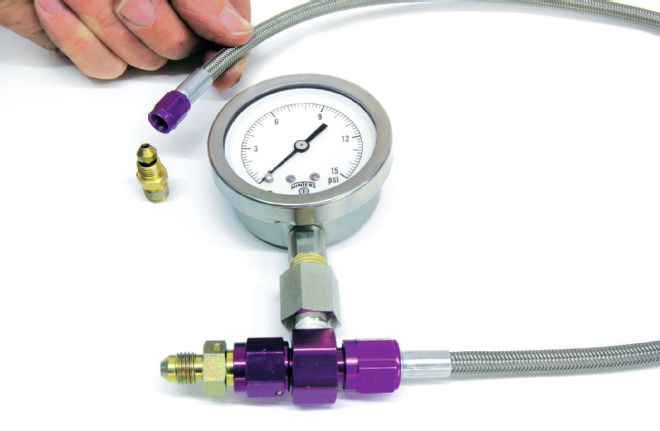
To test nitrous fuel pressure with a separate nitrous fuel-delivery system, plug the fuel jet into the tool and direct the fuel into an appropriate can. The gauge will measure dynamic fuel pressure, and you can adjust the regulator to set the desired pressure.
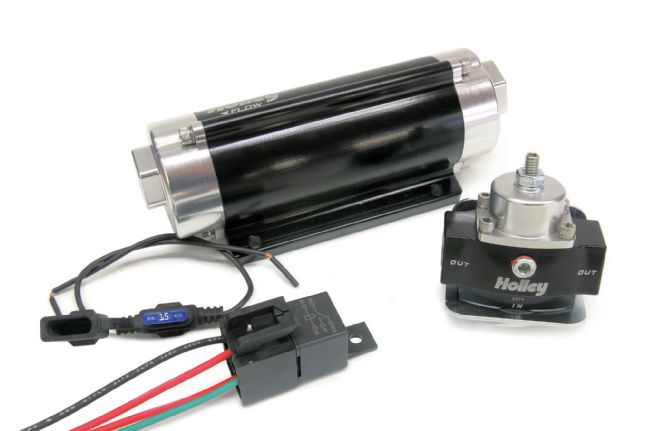
If your plan calls for a single fuel pump to feed both a 450hp engine and a 200hp nitrous system, then the pump and the delivery plumbing must be capable of feeding both the fuel volume (roughly 60 gallons per hour) at the desired pressure. All this needs to happen at a minimum fuel pressure of 6–7 psi that can be regulated to 5.5 or 6 psi at the fuel solenoid.
Ignition Timing
Adding nitrous oxide to an engine radically affects the burn rate of the air and fuel in the cylinder. Generally speaking, combustion occurs at a faster rate, which means that the normally aspirated ignition timing curve is too far advanced. Most nitrous companies suggest retarding timing by 1.5–2.5 degrees per 50 hp of nitrous use. For example, a 200hp nitrous tune would require the timing to be retarded from 6 to 10 degrees. This is most often accomplished with a timing retard feature on an aftermarket ignition control box, such as those from MSD, Crane, Pertronix, or others. The most common ignition box for street/strip cars is the MSD 6AL, but it doesn't offer a built-in retard feature for nitrous. You can purchase add-on retard boxes, but these are expensive. The simplest procedure would be to step up to an ignition box with nitrous retard built in like an MSD Digital 6-Plus or the Mallory Hy-Fire VI box. Both of these capacitive discharge boxes offer a single-stage adjustable ignition retard. Mallory's will retard 1–15 degrees of timing with 0.1-degree increments. One advantage of the MSD 6AL-2 box is its Pro-Data + software that once uploaded to your laptop, offers the freedom to custom create an ignition curve that includes a single-stage nitrous retard.
Beyond nitrous retard, horsepower increases above 100 hp generally will need both a colder spark plug and a plug with a shorter-length ground strap. Typical spark plugs use a projected-nose center electrode to push the spark out farther into the combustion chamber. But this also increases the length of the ground strap. The problem occurs when higher cylinder temperatures turn this ground strap into a glow plug in the combustion chamber. This glowing ground strap can cause pre-ignition, where the incoming air and fuel is auto-ignited by the red-hot glowing metal—causing instant and catastrophic engine damage. We have experienced this on the dyno, and the damage is instantaneous and severe—breaking pistons and cylinder walls. It's not pretty. This has become a problem because of the much higher horsepower levels of modern, combustion-efficient engines. The solution is to use a non-projected-nose spark plug with several steps colder heat range.
None of the tuning issues we've discussed here are difficult to achieve, but nitrous use does require a certain level of discipline. Bottle pressures will be constantly changing, so you will have to be aware of this. With proper preparation, nitrous will deliver consistent performance and can quickly deliver the elapsed times you've already claimed you can run. It's not "cheating" if you can consistently run the number.
Parts List
PN Source Price NOS Cheater 150–250hp kit 02001NOS Summit Racing $597.95 NOS Purge kit 1603NOS Summit Racing 133.95 NOS Purge adapter 16103NOS Summit Racing 24.95 ZEX 100–300hp plate kit 82040 Summit Racing 587.97 ZEX fuel-pressure kit 82224 Summit Racing 169.88 Nitrous Express 100–250hp kit ML1000 Summit Racing 399.52 MSD programmable 6AL-2 6530 Summit Racing 365.97 MSD Digital 6-Plus 6520 Summit Racing 315.97 Mallory Hy-Fire VI 685 Summit Racing 317.97 Crane HI-6R 6000-6400 Summit Racing 299.47 LPE nitrous controller NCC-002 L460240000 Lingenfelter 649.95 NOS nitrous controller 15977NOS Summit Racing 428.95 Edelbrock nitrous controller 71900 Summit Racing 459.97 Nitrous Express controller NXD-5000 Summit Racing 392.11 Induction Solutions Progressive Nitrous Controller NMS-1000 Induction Solutions 699.00 Flow Tool fuel-pressure gauge 19706GO Induction Solutions 125.00 Nitrous pressure gauge, 4 inch 19708-4 Induction Solutions 59.95 Nitrous 1/4-turn ball valve 19705-4 Induction Solutions 59.95 Nitrous plate blueprinting Custom Induction Solutions Starts at 400.00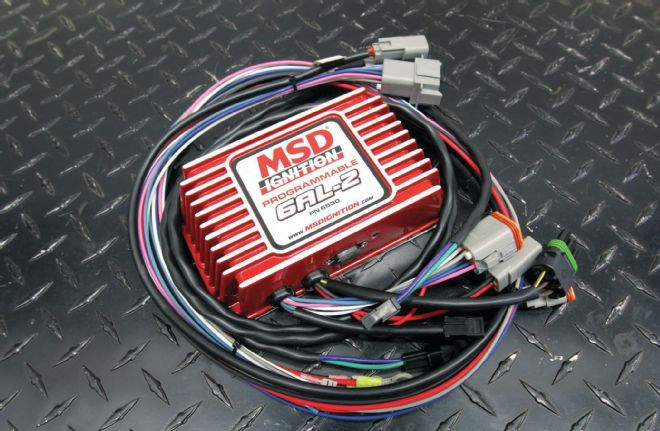
Nitrous makes power by drastically increasing the cylinder pressure, which then puts greater demand on the ignition system. Adding an ignition box is a good idea. We chose an MSD Digital 6 controller because it offered more finite digital control over the ignition curve. Our Lingenfelter progressive nitrous controller was set to start at 40 percent of the 150hp hit. Because of this soft hit, we added 4 degrees of timing into the advance curve at low rpm to compensate for the 8-degree retard that is triggered when the nitrous starts. This effectively retarded the timing only 4 degrees.
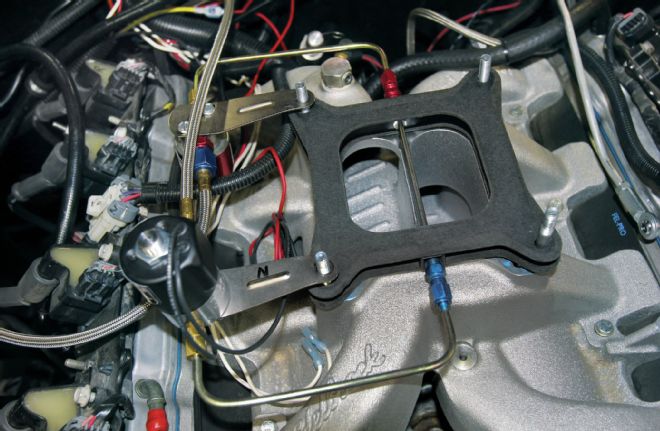
We sent our stock Holley Cheater plate and solenoid assembly to Induction Solutions to take advantage of its blueprint service. The company flow tests all the components, repairs any damage, and rebuilds or replaces damaged solenoids. But the best part is the flow testing, where the company custom sets the nitrous to fuel ratio and includes specific jetting recommendations. We bolted our blueprinted kit on our 4.8L Chevelle and immediately improved 2 mph in trap speed over our previous tune. The Induction Solutions jetting recommendation spun the tires harder, but we made more power with essentially the same nitrous jet.
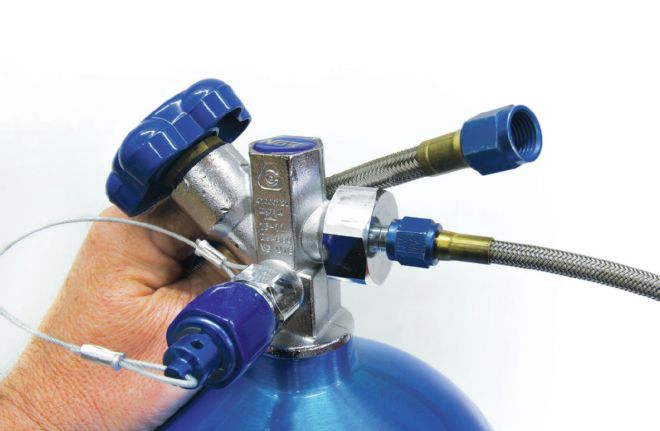
Most basic nitrous kits come with a -4 feed line between the bottle and the nitrous solenoid. This is fine for 200hp systems, but once you begin to feed 300 hp or more with nitrous, it's best to upgrade to a larger -6 feed line. Pay close attention to the fittings because flow area can often be restricted by budget fittings. Johnson says the brass inserts are generally less restrictive.
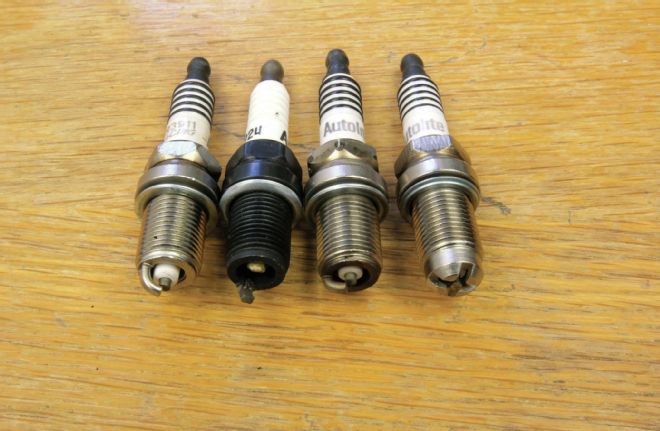
On the far left is a typical long-reach spark plug with its extended ground strap. In the center is a spark plug where the ground strap has been melted off from excess heat from a 200hp nitrous shot. Next to it is a short-reach Autolite spark plug. Its shorter ground strap provides a quicker path for the heat to escape. On the far right is one of the new Autolite X plugs, which are essentially surface-gap spark plugs that eliminate the ground strap altogether.